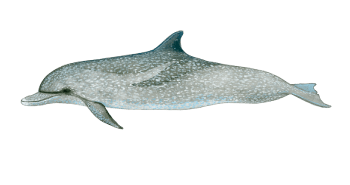
Atlantic spotted dolphin
(Stenella frontalis)
The skin of adult animals, particularly those of the coastal form is covered in pale spots. Animals from different regions may have significantly different spot patterns.
Juveniles have no spots and resemble bottlenose dolphins, for which they are often mistaken. Two main ecotypes of spotted dolphins are distinguished: a larger, more sturdy coastal form and an offshore form.
These animals are usually smaller and have less spots. These small delphinids often occur in large schools with a very complex social structure.
General information
Further names: Portuguese: Golfinho-pintado-do-Atlântico
Size of adults: 1.7 – 2.3 m
Prey: Fish, squid and bottom-dwelling invertebrates.
Behaviour: Fast swimming, interactive species, often leaping or boarding near vessels. In certain areas, they even approach people in the water (Bahamas, USA).
Range: Warm temperate to tropical waters of the Northern and Southern Atlantic.
Madeira: Seasonal species. More abundant in the summer months.
Distinctive features: Head and body shape rather sturdy. Long beak with white tip. Dark grey cape on the back reaching from the head to the tail-fin and white belly. Clearly visible, falcate (sickle-shaped) dorsal fin. Adults with distinctive spotted coloration.
Taxonomy: Suborder: Odontoceti (Toothed whales), Family: Delphinidae (Dolphins)
Threats: No reliable information on population size. Threatened by being caught in fishing nets as bycatch or through entanglement.
